
by Jennifer Hart Yim | Mar 19, 2018 | Blog, Current Events, Logistics, Strategy, Supply Chain
More than half of the UK’s Kentucky Fried Chicken stores recently closed because they ran out of chicken. Here’s a look at what caused the issues and what supply chain lessons can be learned.
This guest post comes to us from Argentus Supply Chain Recruiting, a boutique recruitment firm specializing in Supply Chain Management and Procurement.
There’s another unfortunate entry in the annals of Supply Chain failures that burst into the wider world of business and pop culture: More than half of the UK’s Kentucky Fried Chicken stores recently closed because they ran out of chicken. We’ve written on the Argentus’ blog many times about Supply Chain misadventures, and how they can harm a brand’s reputation as well as profits – for example, maybe most memorably, in the case of Target, which had to retreat from the Canadian market after Supply Chain snafus led to empty shelves and disappointed customers.
Although Supply Chain Management is taking off in terms of recognition within business, it still doesn’t get a lot of attention from the wider world – until it fails, at which point the stresses and pressure of beleaguered Supply Chain teams become an object of fascination as the organization races to play catch up and get things back online.
KFC’s UK operations are the latest such story. On February 19th, outlets began reporting about the closure of about half of the chain’s 900 stores in the country, due to delivery failures after changing their 3rd Party Logistics (3PL) provider from Bidvest Logistics to DHL. A few weeks later, reports are that a number of stores are still closed, with front-line workers being encouraged to take holidays as the company sorts out its deliveries and tries to account for the failures. It’s no wonder that the closures have been met with derision across the internet: delivering chicken to the people is pretty much KFC’s #1 job.
So what has caused the issues, and what lessons are there to be learned?
According to the BBC, KFC recently switched its 3PL operations from food specialist Bidvest Logistics to international heavyweight DHL – the latter being a company with operations in a number of different industries, now navigating a country-wide Supply Chain out of one distribution centre location. In short, DHL took over the contract on Valentine’s Day, and delivery failures started to happen on February 16th – an extraordinarily short time table for Supply Chain issues to get so dire that customers see disruptions.
While there’s some disagreement among experts about the exact cause of the failed deliveries, speculation is that many of the problems can be attributed to the fact that DHL has one distribution centre location serving the entire country – a bottleneck that wasn’t seen with the previous 3PL provider, who had six distribution centre locations.
While Supply Chains gain a lot of their competitive advantage from offering lower costs and greater efficiencies, it seems that the shift in providers was a cost-cutting maneuver that’s ended up costing the company’s brand — with some analysts predicting something on the order of 20% of a hit to the company’s share prices once the disruption finishes shaking its way through the system. It underscores the importance of sound planning and reliability in Supply Chain Management in an era where companies are looking to gain an edge with margins wherever they can. It’s also great evidence for what many of us know: an approach that puts cost-cutting first can cause more problems than it solves.
John Boulter, the Managing Director of DHL’s operations for retail in the UK and Ireland issued a statement saying, “The reasons for this unforeseen interruption of this complex service are being worked on with a goal to return to normal service levels as soon as possible. With the help of our partner QSL, we are committed to step by step improvements to allow KFC to reopen its stores over the coming days. Whilst we are not the only party responsible for the supply chain to KFC, we do apologize for the inconvenience and disappointment caused to KFC and their customers by this incident.”
Ouch. Boulter’s statement has two issues that, from our perspective, show a lack of the accountability necessary to restore credibility both with DHL’s immediate customer (KFC) and the wider base of customers disappointed that they can’t buy KFC’s fried chicken:
- The statement attempts to shift blame onto DHL’s other partners in the deliveries (particularly QSL) in a way that looks passive aggressive. Admitting responsibility is the first step to restoring credibility when responding to Supply Chain failures, and while DHL accepts some blame for the issues, the statement doesn’t go far enough.
- Going out of their way to describe the service as “complex” doesn’t do any favours for DHL in this situation. Of course modern Supply Chains are complex. Understanding that complexity, and being able to deliver anyway, should be considered table stakes for providers in 2018. To implicitly chalk delivery failures up to a complexity that your predecessor – in this case Bidvest Logistics – handled without issue for years, casts even more doubt on DHL’s competency. At the same time, the fact that analysts are having such agreeing on an explanation for these issues – despite the fact that KFC only has a few poultry suppliers in the UK – says a lot about just how complex modern-day Supply Chains have become.
Logistics failures leading to the closure of stores is pretty much the worst case scenario for Supply Chain teams everywhere, so all of us across the community are probably watching this story with bemused shock and sympathy for those involved.
Hopefully DHL – which is, after all, the biggest logistics provider in the world – can get these issues solved soon, but in the meantime, let us know in the comments: are there any further lessons you think that Supply Chain professionals can draw from KFC’s recent woes?
Related posts:
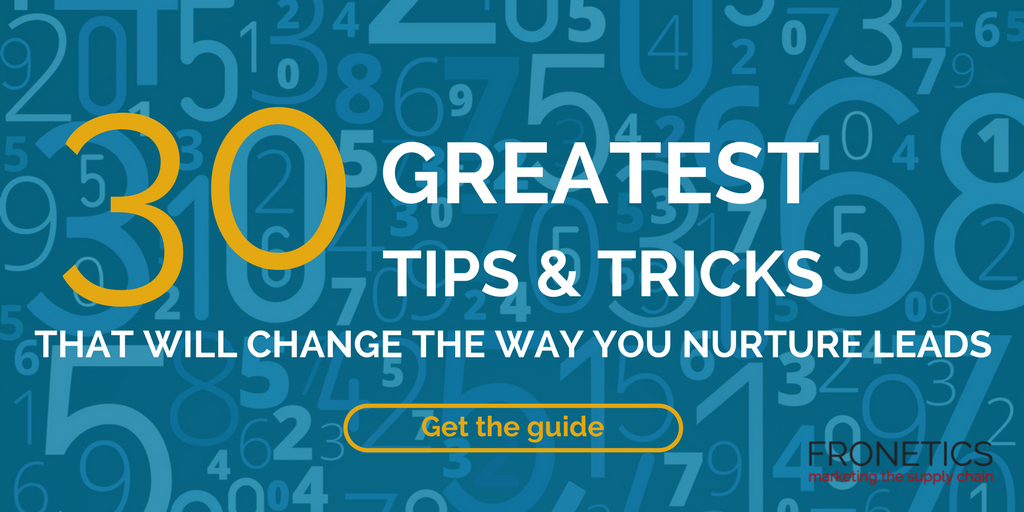

by Fronetics | Mar 15, 2018 | Blog, Content Marketing, Logistics, Marketing, Strategy, Supply Chain
Here are four simple steps to help you measure your company’s content marketing ROI and the success of your strategy.
Lean-startup pioneer Eric Ries said, “The only metrics that entrepreneurs should invest energy in collecting are those that help them make decisions.” In other words, measure the things that will tell you if an effort was profitable so you know where to put your time and money.
But most companies aren’t using the right metrics to track their content marketing ROI. For example, 83% of B2B enterprise companies (over 1,000 employees) use web traffic as their main metric for measuring content marketing ROI. A spike in homepage hits could be the result of your hard work, but it could also be ghost spam, or even both! So clearly, web traffic isn’t the most reliable metric.
Content marketing ROI is harder to quantify than checking a few quick numbers. But don’t give up hope. In the article How to Measure Content Marketing ROI: A Simple 4 Step Process, marketing consultant Bill Widmer breaks down a simple, four-step process that will quickly and effectively measure your content marketing ROI.
What is content marketing ROI?
Content marketing ROI is how much revenue you gain from content marketing in comparison with what you spend on creating and distributing content. It’s an actual percentage that shows how much revenue you gained vs. how much money you spent. And for a lot of businesses (and bosses), this percentage is very important. They want you to be able to prove that the marketing dollars that are going into your content marketing strategy are actually pulling in new business.
Every company has specific key performance indicators (KPIs) that help shape their marketing strategies. Here at Fronetics, we believe that your content marketing strategy should take these KPIs into consideration when thinking about your ROI:
- Website traffic
- Leads generated
- Conversion rate
- Direct sales
Obviously content marketing has more benefits than these four KPIs demonstrate — including better customer retention, brand awareness, and improved SEO — but to begin to measure your ROI, let’s focus on these four main points.
Measure content marketing ROI in 4 simple steps
1. Download your reverse goal path data.
Andy Crestodina, co-founder and CMO of Orbit Media, suggests:
- Go to your analytics dashboard. Set the date range for at least a year.
- Go to Conversions > Goals > Reverse Goal Path.
- Add a filter like “/blog” so only blog posts show up.
- Sort by Goal Completions.
After this step, you’ll be able see which of your posts have driven the most conversions. But you can’t stop there. These are simply conversion numbers. We want those numbers to become conversion rates, so let’s keep going.
2. Download your pageview data.
In order to calculate a conversion rate, you need to know pageviews. Here’s how to get that information:
- Go to Content > Site Content > All Pages.
- Filter with “/blog” to get only blog posts.
Download this data into the spreadsheet from step one.
3. Get your conversion rate.
Now here’s a little math for you. Divide the data in the “conversions” column by the number in the “unique pageviews” column. This will give you your conversion rate per blog post.
This will show you what your best-performing pieces of content are, and what posts need to be updated to gain more views and shares.
This information will give you valuable insight into the topics that your target audience are reading about and how you can better plan for high-ranking content in the future.
If you have posts or pages that are older — like over a year — and they haven’t gotten any views or conversions, it’s time to think about reworking them to have more appeal to your target audience.
For your actual percentage, you’ll need to calculate how many of these leads have converted to sales.
4. Calculate content marketing ROI based on lead conversions.
Here’s where things get a little more complicated, but still very manageable. You need to start putting tags on your leads according to the content they came from.
You can use programs like WordPress or Blogger to help you automatically tag any leads that came from a specific form. Assuming the form correlates to a single blog post, you will know that any leads with that tag came from that post.
You can also connect your leads with a CRM, such as HubSpot or SalesForce, and track which leads came from specific emails. These programs easily integrate with your analytics and email marketing platforms for up-to-date numbers and data.
Related posts:
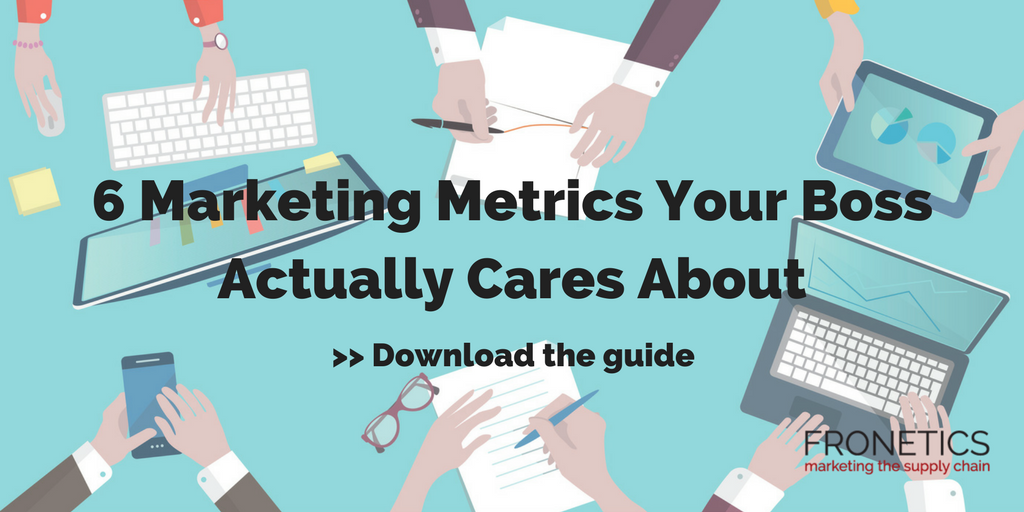

by Fronetics | Mar 8, 2018 | Blog, Content Marketing, Logistics, Marketing, Strategy, Supply Chain
Use these 4 steps to determine the topic clusters that will be best for driving organic traffic to your business’ website.
You’ve determined your pillar content and written your pillar pages. Now what? It’s time to develop topics clusters.
Topic clusters show search engines that your website contains breadth and depth on a particular subject, which will help them decide to show your page over others in a user’s search for that subject.
Determining what topic clusters to use can be overwhelming — as can figuring out how to optimize blog posts that contain cluster content. Let’s take a step back and think a little about what a topic cluster is.
HubSpot Academy has a great succinct summary: “Topic clusters are comprised of a pillar page and subtopic content that you’ve compiled for each of your core topics.”
So how do you go about developing topic clusters? We’ve put together a four-step guide to get you started.
4 steps to developing topic clusters
1) Choose your topic.
This is all about determining where you can or strive to be a thought leader. Pick topics that are fundamental to your business, places where you can be a resource for potential buyers and industry peers. Define these topics with a name that summarizes the content it will address.
Chances are, you’ll have some supporting content already. Conducting a content audit will help you determine how much you have in place already.
2) Compile subtopics.
HubSpot recommends having “6-8 subtopics that address specific questions your customers may be exploring related to the core topic of your pillar page.” Other sources recommend between 10-20 subtopics. It depends on how broad your main topic is. (But if you can come up with more than 20 subtopics, your topic is definitely too broad!)
Conduct a brainstorming session with your team to think about relevant content that your target buyers would seek out when researching products and solutions.
Simple Marketing Now blogger Christine B. Whittemore suggests starting with identifying the problems your buyer persona faces. “Map out 5-10 core problems that your core persona has. Use research… to truly understand your buyer persona problems, including the world used to describe them.”
3) Develop pillar pages.
Now that you have a list of topics and subtopics, you need to develop your pillar pages. These pages will extensively — and broadly — cover each main topic, and they will include links to each subtopic.
Inbound Marketing Specialist Sarah Seward suggests using “relevant pictures, high-quality and interesting content, compelling headers, and any additional, related resources, such as a custom graphic visually demonstrating your expertise on a topic.”
4) Create!
Now it’s time to create your content (or brush up existing content you discovered in your audit). Be sure to link pages covering your subtopics to your pillar pages, using the correct anchor text. That means hyperlinking words that are relevant to the topic and subtopics.
Additionally, you can link subtopics together where appropriate. The more often you can create relevant links, the better.
Now repeat this process until you’ve created several topic clusters that best define your business. This SEO strategy will help ensure that prospective customers that are searching for products or services like yours will be more likely to visit your website and patronize your business.
Related posts:
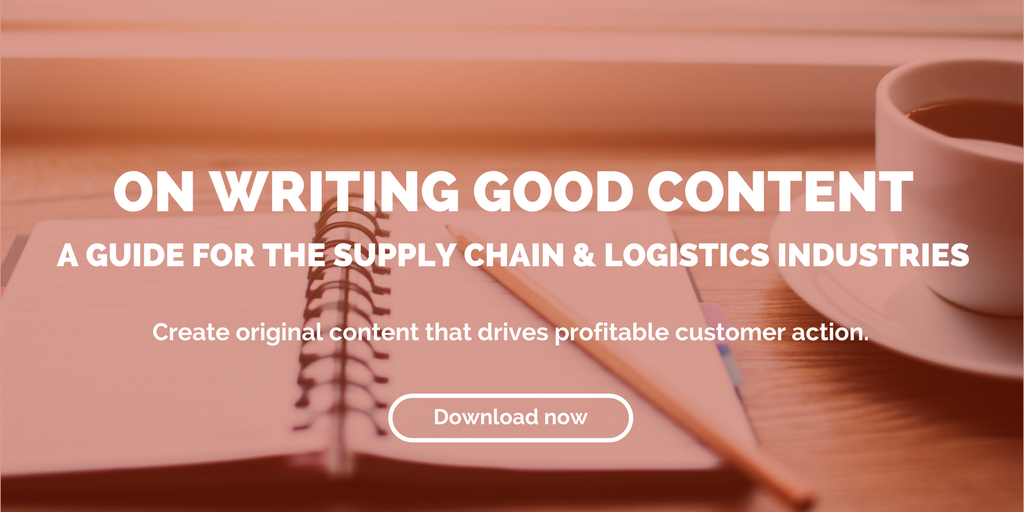

by Fronetics | Mar 7, 2018 | Blog, Content Marketing, Logistics, Marketing, Social Media, Strategy, Supply Chain
Linkless backlinks, or mentions of your business without a hyperlink to your webpage, are now a more effective way to improve your ranking with search engines.
For years Google has used backlinks to rank webpages. Backlinks are any link on another website that points (or links) back to your website. Unfortunately, search engines began to use backlinks as a bit of a popularity contest: The more you had, the more popular your website became.
Businesses quickly understood the loophole in search engines’ algorithms. They could buy, influence or even create relationships with other industry businesses for the sole benefit of getting links to their websites. It didn’t take long for search engines to catch on.
Google has spent years reworking the way it ranks backlinks and trying to penalize brands that pay for or create free links through unethical relationships. But where does that leave the rest of us that are working to create high-quality content in hopes of increasing our SEO rankings?
Linkless backlinks are the future of SEO rankings
You might be asking yourself what is a linkless backlink? Good question.
Linkless backlinks are mentions of your business or brand without a hyperlink to your webpage. In a keynote speech in September 2017, Gary Illyes, a webmaster trend analyst for Google, said:
“Basically, if you publish high-quality content that is highly cited on the internet — and I’m not talking about just links, but also mentions on social networks and people talking about your branding — then you are doing great.”
It all comes down to mentions of your brand on reputable websites. And I don’t just mean backlinks to your webpage. Other sites’ tweeting about your products or mentioning you on their Facebook News Feed can all lead to increased rankings on Google and other search engines. Sounds easy, right?
How to make linkless backlinks work for you
The principles that help you gain backlinks are still true for gaining linkless backlinks. You want to focus on creating the most accurate, high-quality content you can. Create videos and infographics for your website to add visual appeal. And collaborate with other industry leaders to reach new audiences.
But there are a few other tips you can use to help boost your SEO ranking with linkless backlinks.
3 tips for building a strategy for linkless backlinks
1. Work to increase brand awareness and reputation
The foundation of linkless mentions is reputation building. Search engines are looking for authentic mentions of products and brands in content that helps build authority around an industry topic.
Increase your brand awareness by growing your social media presence, by encouraging followers and loyal customers to write online reviews of your products and services, and by participating in collaborative content marketing.
2. Track brand awareness and mentions
You’re working hard to create content that has a far reach across many platforms. It’s a key step in gaining exposure among potential customers and earning new business. This process is called brand awareness, the extent to which consumers are familiar with your brand. And for linkless backlinks, it’s imperative that you’re tracking all of your brand mentions, not just links.
There are several tools to help you track brand mentions online. Here at Fronetics, we prefer the ease of Google Alerts, which sends you a message when someone mentions your brand online. We also use Hootsuite, with which you can track brand mentions, as well as keywords and phrases, across all of your social media platforms.
3. Stay on top of negative mentions
Blog comment sections and social media channels offer an open avenue for customers to discuss their thoughts about your company for all the world to see. And, unfortunately, one negative comment can be infinitely louder than one hundred positive ones. The potential impact it could have on business is scary.
But that doesn’t mean you should delete or ignore every unfavorable brand mention. In fact, companies can use negative online comments as an opportunity to exhibit top-notch customer service and much-appreciated transparency in the way they do business.
Be diligent in monitoring brand mentions and respond quickly to resolve any issues that arise. Responding promptly and effectively to negative feedback online shows your commitment to customer service and transparency.
The art of SEO building is a tough craft to master. As algorithms evolve, it’s important for brands to stay aware of these changes and focus on what they can do to help boost their rankings.
The more buzz around your brand, the better your ranking will be. So make sure you’re utilizing all the different ways to help boost your SEO ranking, including linkless backlinks.
Need more help with SEO? We’ve done the research, so you don’t have to. Have a look.
Related posts:


by Fronetics | Mar 1, 2018 | Blog, Content Marketing, Logistics, Marketing, Strategy, Supply Chain
Brand awareness is key in optimizing your content marketing efforts but can be challenging to quantify. Here are four metrics to help you measure brand awareness.
Brand awareness is the extent to which potential customers recognize a brand and associate it with specific products and services. Making the public aware of your company is a long-term goal of content marketing. Through social media, blogs, and other platforms, content marketing works to create brand awareness and strengthen trust with target customers. Drawing the public’s attention to — and heightening their knowledge of — your business ultimately generates leads that turn into sales, after all, which is the end marketing objective.
But it has been notoriously difficult to quantify how effective your content marketing strategy is (and, more specifically, how far your brand awareness reaches). Unlike vanity metrics, which are easy to quantify, measuring brand awareness takes more than just a simple calculation. But that doesn’t mean you shouldn’t take the time to measure brand awareness.
Understanding the value of brand awareness gives companies insight into how well their content marketing strategy is working to generate leads and drive sales. As marketing ROI guru Jim Lenskold writes:
“The value of brand awareness is the equivalent of half of a $100 bill. Unless you know where to find the other half, there really is no value. Brand awareness does not have a financial value on its own but is part of the collective effort necessary for marketing to drive incremental sales.”
Brand awareness is key to reaching and influencing potential customers. Here are some metrics to help your measure your brand awareness.
4 ways to measure brand awareness
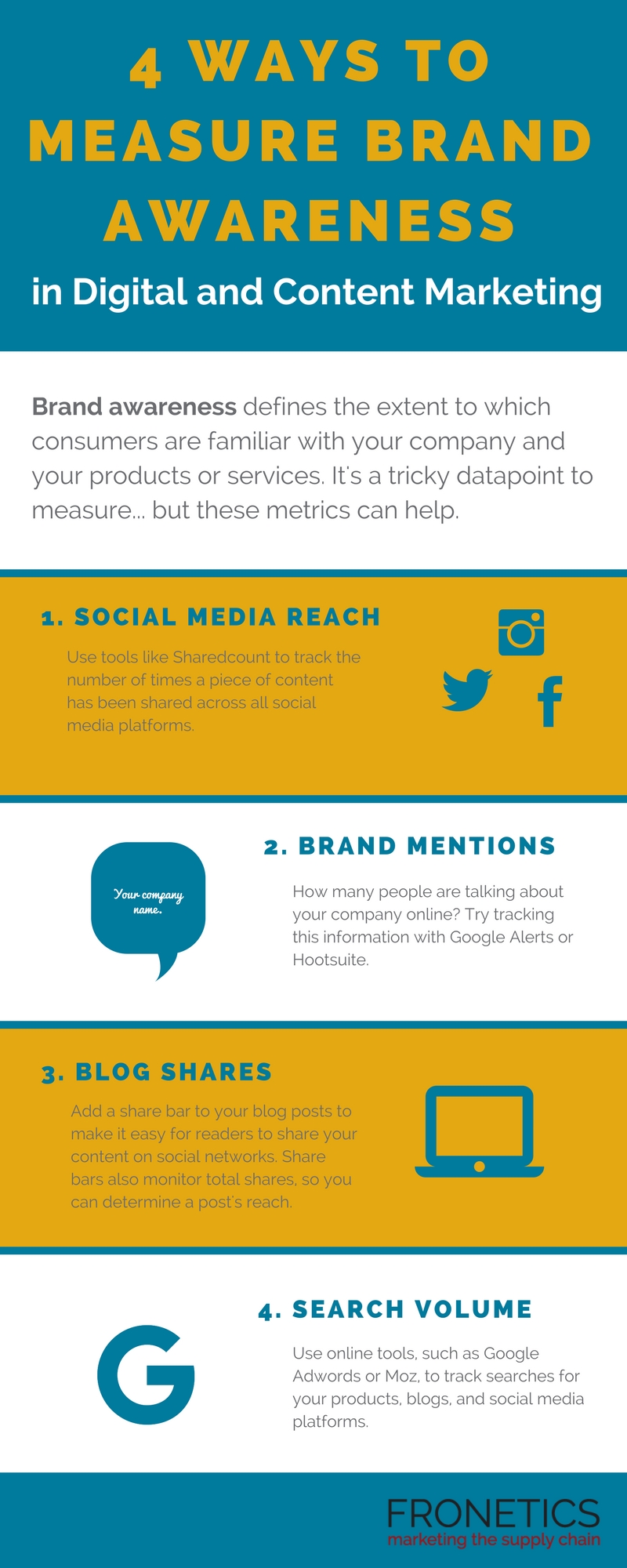
(Made with Canva)
Ultimately, the more aware audiences are about your brand, the more likely they are to buy your products or services. From familiarity grows trust, which only helps to strengthen your brand and create new relationships with potential customers.
Taking the time to measure brand awareness will help to maximize the success of your content marketing strategy and increase leads. These four metrics will give you a good indication of how familiar your target audiences are becoming with your company.
Related posts:


by Fronetics | Feb 8, 2018 | Blog, Content Marketing, Logistics, Marketing, Social Media, Strategy, Supply Chain
These social media statistics are important to keep in mind when planning out your content marketing strategy.
A strong social media presence is key to successful marketing in 2018. Social media is simply unavoidable these days.
So, you jumped on board and you’re posting and tweeting. You’re creating content. You’re learning about search engine optimization and how to improve your rankings. But you’re still not reaching the audiences you were hoping to attract. What’s going wrong?
When you are posting on social media could be as important as what you’re posting.
Timing is everything, and that statement especially holds true when it comes to posting content to social media. If you are sending out your message and nobody is there to see it, you are that proverbial tree falling in the forest; you did not make a sound. Your post had little to no impact.
So, even if you are putting in the time and effort to craft informative blog posts, tweets with just the right message, or Facebook posts that inspire more than just page likes, you still are not getting the most exposure you can out of social media.
We have done our homework when it comes to the best times to post on social media. And the truth is there is no “one size fits all” answer to when you should post. There are general guidelines that differ for each site. But in general, it’s important to keep your target audience in mind when deciding where and when to post.
Here are some social media statistics that you need to consider when deciding when to post your content.
Social media statistics your business needs to consider when publishing content
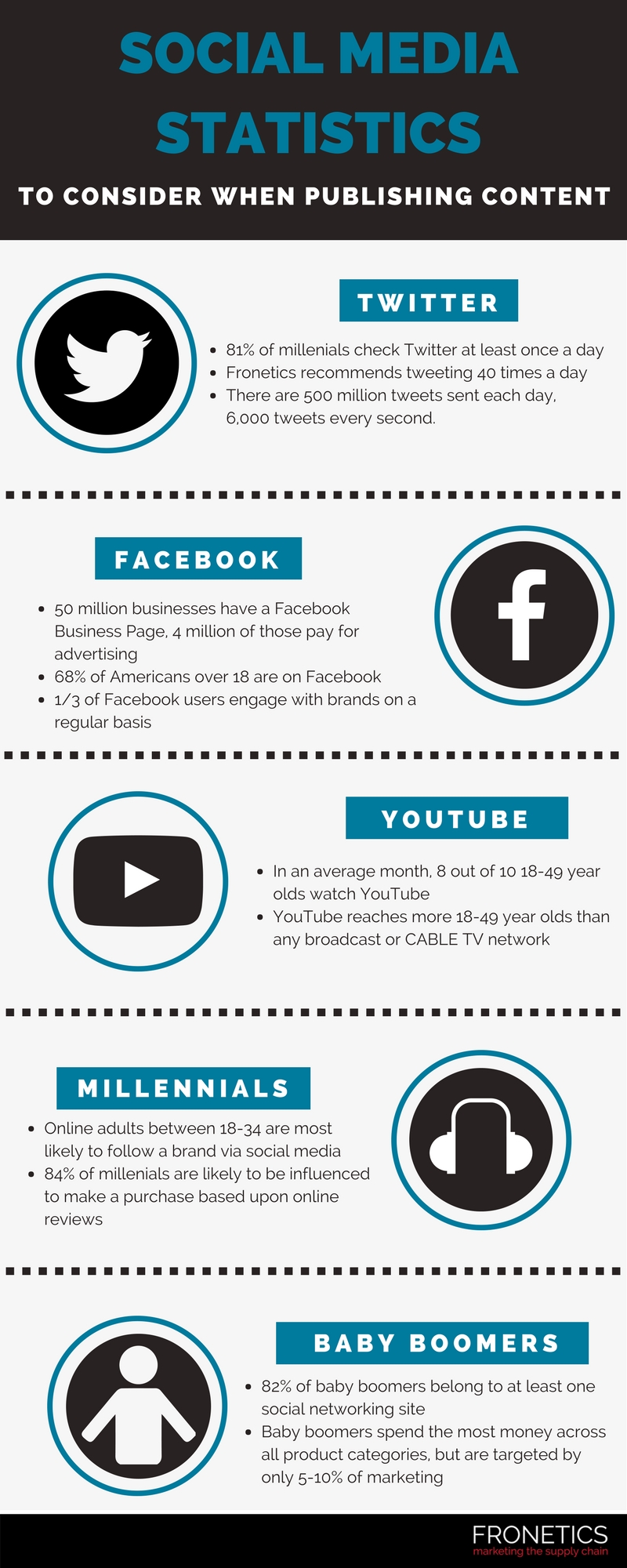
(Made with Canva)
Related posts:

SaveSave
SaveSave














